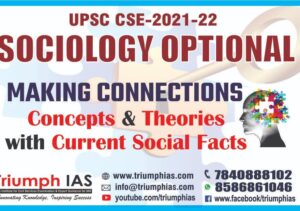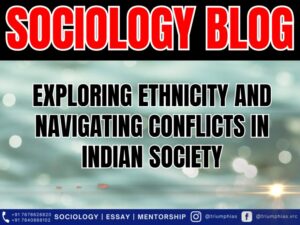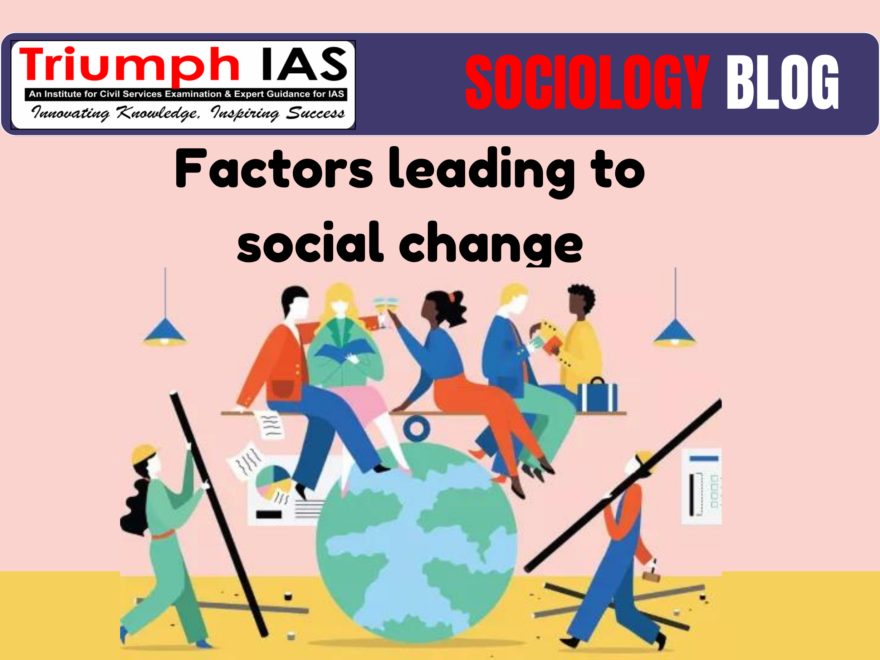Relevant for Sociology Optional for Civil Service Examination.
Sociology Paper -1
Unit 10 : Social Change in Modern Society
Factors leading to social change
Social change is brought about by various factors. These factors are mainly responsible for the differences in the rate and nature of change in different societies and at different times. They may be broadly classified into the following categories
-
- Biological factors,
- Geographic factors,
- Technological factors, and
- Socio-cultural factors
- Biological Factors: Biological factors may be further classified into two types– non-human biological factors, and human biological factors. Biological factors, encompassing plants and animals, significantly impact human life, serving essential needs like food, clothing, and medicine.
- Humans both rely on and manage these elements, eliminating harmful species while benefiting from processes like photosynthesis. Changes in the ecological system, influenced by geographic factors, affect human survival struggles. Modern advancements, like domestication and technology, enable some control over environmental instability. Human biological factors contribute to social change through genetic characteristics and population dynamics.
- While genetic influences are noteworthy, population growth and composition play a pivotal role in socio-cultural shifts. Technological and healthcare progress has led to increased life expectancy, impacting population size and societal changes.
- Migration introduces new challenges, influencing acculturation, cultural diffusion, and social conflicts. In regions like India, where population growth outpaces food productivity, potential consequences include efforts to enhance agriculture, migration, and population control measures. Overall, population changes serve as catalysts for further social and cultural transformations.
- Geographic factors have played a significant role in driving social change throughout history. Notable instances include the obliteration of Pompeii’s population by volcanic eruptions, the devastation of San Francisco through an earthquake and fire in 1906, the Irish migration to the United States following the potato famine in the 1840s, and the movement of Southern United States residents to Southern California due to drought in the 1930s.
- Natural disasters can trigger both environmental and social transformations, leaving survivors grappling with psychological trauma and forcing them to rebuild their lives and communities.
- Ecological changes, often induced by human activities, are another key driver of contemporary social change. Population size, resource utilization, and the exploitation of natural resources significantly contribute to both ecological and social transformations. Factors such as overpopulation, conflicts leading to the overexploitation of border areas, deforestation, and the construction of large dams have resulted in substantial social and ecological challenges. These issues are identified as more influential factors of social change than migrations and disasters.
- Technology is a pivotal force driving social change, particularly in the contemporary world. The impact of technological advancements on social organization varies depending on the period and context, influenced by the availability and utilization of technology. In ancient times, societal changes were gradual, as evidenced by the use of rudimentary tools like stone implements.

-
- The introduction of machine technology, fuelled by advanced energy sources, has led to profound transformations. Modern technologies, such as industrial, green, and technical revolutions, have significantly altered modes of production, relations of production, social organization, ideologies, attitudes, beliefs, and traditions. These revolutions have prompted humans to adapt to changing material environments shaped by technology.
- Inventions like gunpowder, atom bombs, and nuclear weapons have revolutionized warfare Modern transport networks have increased mobility and accessibility to distant places. Communication systems like writing, telephones and the internet facilitate easy interaction across geographical boundaries. Advances in modern medicine have contributed to substantial improvements in human health.
- The industrial revolution has shifted societies from agrarian to industrial production, impacting family relations, religion, and other institutions. Similarly, the green revolution has induced changes in society.
- Despite the positive aspects, technology has a dark side, manifested in the disruption of traditional ways of life, the destructive nature of certain technologies, and their misuse for harmful purposes. The perceived ill-effects include the disintegration of community life and the promotion of individualism. The misuse of modern technologies has led to human-induced disasters, highlighting the alarming consequences. While technology has been a boon, it is essential to recognize and address the potential negative impacts on society and its institutions, emphasizing responsible and ethical use.
- Socio-cultural factors, driven by human activities, play a central role in instigating social changes. Man serves as the primary initiator and agent of socio-cultural transformations through activities like discovery, invention, diffusion, and participation in social movements. Attitudes and values toward innovation within a society contribute to the pace and nature of change, varying among individuals.
- Societies situated at crossroads with significant intercultural contact are often hubs of change. Proximity to other societies facilitates rapid change through the process of diffusion, influenced by factors like war, trade, media, and tourism. Conversely, isolated areas tend to exhibit stability, conservatism, and resistance to change, as observed in primitive tribes residing in secluded communities.
- Discoveries and inventions, especially in the era of modern technological advancements, significantly impact social change. Discoveries involve finding previously unknown elements, while inventions entail combining existing elements in new ways. Examples include the discovery of America leading to mass migrations and the creation of the United States, the discovery of penicillin preventing diseases, and the discovery of oil bringing about social changes in relevant localities. Inventions like the alphabet, modern state, automobile, and telephone have also contributed to substantial social transformations.
- Diffusion, the spread of culture between and within groups, is a key driver of social change. The process is impeded in isolated situations, and examples include the diffusion of jazz from black musicians in New Orleans to various groups within the society and its subsequent spread globally.
- Social movements represent a crucial factor in social change, categorized into those creating new radical forms and those maintaining or recreating older forms. Success in these movements determines the extent of social change. Revolutionary movements, exemplified by the French Revolution of 1789 and the Russian Revolution, bring about significant social transformations, such as the rise of democracy and the end of monarchical government.
Reference: Static Portion
Related Blogs…
 |
 |
Frequently Asked Questions:
1. Question: Define the term “ethnic movement” and provide an example from India.
Answer: An ethnic movement refers to a collective effort by a group sharing common cultural, linguistic, or religious traits, seeking to assert their identity and rights; an example from India is the Khalistan Movement in Punjab.
2. Question: Identify the main objectives behind the Gorkhaland ethnic movement.
Answer: The Gorkhaland ethnic movement primarily seeks to establish a separate state for India’s Nepali-speaking population in the Darjeeling region, advocating for linguistic and cultural recognition and political autonomy.
3. Question: What was the Operation Blue Star, and which ethnic movement was it related to?
Answer: Operation Blue Star was a military action in 1984, aiming to remove Sikh militants hiding in the Golden Temple in Amritsar; it is related to the Khalistan movement, which sought a separate Sikh country.
4. Question: Mention a critical factor that triggered the emergence of ethnic movements in India, as discussed by Dipankar Gupta.
Answer: Dipankar Gupta emphasized that ethnicity is fundamentally a political process, wherein caste and religion, the key components of identity formation, are politicized by leaders for vested interests.
5. Question: What were the primary reasons for the Assam Ethnicity conflicts involving Bodo tribals and Bengali Muslim settlers?
Answer: The Assam Ethnicity conflicts primarily stemmed from issues related to immigration, land rights, and resource allocation, leading to clashes, riots, and evolving relationships among indigenous communities to address challenges.
6. Question: Briefly describe the role of the Dravidian Movement in terms of caste and societal structure.
Answer: The Dravidian Movement, led notably by E.V. Ramasamy, aimed to establish an egalitarian society, focusing on anti-Brahmanism and advocating for equal rights for backward castes, while also introducing reforms like self-respect marriages.
7. Question: Name the prominent ethnic movements in North-East India and specify one common objective.
Answer: Prominent ethnic movements in North-East India include the Nagas’ and Mizos’ struggles; a common objective was to gain autonomy and recognition for their distinct tribal identities and cultural uniqueness.
8. Question: What is the key argument of Gail Omveldt regarding traditional Indian society and multiculturalism?
Answer: Gail Omveldt opposed romanticizing traditional Indian society, arguing that hierarchy has always dominated it and dismissing the notion that multiculturalism is an intrinsic feature of Indian society as a myth.
9. Question: Briefly explain the social hierarchy factor as a contributing element to ethnic movements as suggested by Olzak.
Answer: Olzak suggests that the construction of hierarchies among ethnic communities, which often leads to the suppression of one group by another, is a key factor that can instigate social and ethnic movements.
10. Question: Identify one consequence of the unequal economic development factor within the context of ethnic movements in India.
Answer: One consequence of unequal economic development is the marginalization and underdevelopment of certain groups, leading to feelings of alienation and sometimes initiating ethnic movements as these groups strive for equality and recognition.
GS Related Practices Questions…
To master these intricacies and fare well in the Sociology Optional Syllabus, aspiring sociologists might benefit from guidance by the Best Sociology Optional Teacher and participation in the Best Sociology Optional Coaching. These avenues provide comprehensive assistance, ensuring a solid understanding of sociology’s diverse methodologies and techniques.
META TAGS:
Ethnic Movements, ethnic movements in india, ethnic movement in sociology, Punjab Movement, North-East Ethnic Movements, Gorkhaland Movement, Dravidian Movement, Assam Ethnicity, Ethnic Conflicts, Sociopolitical Impact, India, Ethnic Consciousness, Ethnic Rights, Political Crisis, Economic Development, Cultural Disparities, Khalistan Movement, Nagaland, Mizoram, Multiculturalism, Political Economy, Identity Formation, Social Hierarchies, Bodo Tribals, Bengali Muslim Settlers, Anti-Sikh Riots, Operation Blue Star, Unequal Development, Ethnic Violence, Political Mobilization

Why Vikash Ranjan’s Classes for Sociology?
Proper guidance and assistance are required to learn the skill of interlinking current happenings with the conventional topics. VIKASH RANJAN SIR at TRIUMPH IAS guides students according to the Recent Trends of UPSC, making him the Best Sociology Teacher for Sociology Optional UPSC.
At Triumph IAS, the Best Sociology Optional Coaching platform, we not only provide the best study material and applied classes for Sociology for IAS but also conduct regular assignments and class tests to assess candidates’ writing skills and understanding of the subject.
Choose The Best Sociology Optional Teacher for IAS Preparation?
At the beginning of the journey for Civil Services Examination preparation, many students face a pivotal decision – selecting their optional subject. Questions such as “which optional subject is the best?” and “which optional subject is the most scoring?” frequently come to mind. Choosing the right optional subject, like choosing the best sociology optional teacher, is a subjective yet vital step that requires a thoughtful decision based on facts. A misstep in this crucial decision can indeed prove disastrous.
Ever since the exam pattern was revamped in 2013, the UPSC has eliminated the need for a second optional subject. Now, candidates have to choose only one optional subject for the UPSC Mains, which has two papers of 250 marks each. One of the compelling choices for many has been the sociology optional. However, it’s strongly advised to decide on your optional subject for mains well ahead of time to get sufficient time to complete the syllabus. After all, most students score similarly in General Studies Papers; it’s the score in the optional subject & essay that contributes significantly to the final selection.
“A sound strategy does not rely solely on the popular
Opinion of toppers or famous YouTubers cum teachers.”
It requires understanding one’s ability, interest, and the relevance of the subject, not just for the exam but also for life in general. Hence, when selecting the best sociology teacher, one must consider the usefulness of sociology optional coaching in General Studies, Essay, and Personality Test.
The choice of the optional subject should be based on objective criteria, such as the nature, scope, and size of the syllabus, uniformity and stability in the question pattern, relevance of the syllabic content in daily life in society, and the availability of study material and guidance. For example, choosing the best sociology optional coaching can ensure access to top-quality study materials and experienced teachers. Always remember, the approach of the UPSC optional subject differs from your academic studies of subjects. Therefore, before settling for sociology optional, you need to analyze the syllabus, previous years’ pattern, subject requirements (be it ideal, visionary, numerical, conceptual theoretical), and your comfort level with the subject.
This decision marks a critical point in your UPSC – CSE journey, potentially determining your success in a career in IAS/Civil Services. Therefore, it’s crucial to choose wisely, whether it’s the optional subject or the best sociology optional teacher. Always base your decision on accurate facts, and never let your emotional biases guide your choices. After all, the search for the best sociology optional coaching is about finding the perfect fit for your unique academic needs and aspirations.
To master these intricacies and fare well in the Sociology Optional Syllabus, aspiring sociologists might benefit from guidance by the Best Sociology Optional Teacher and participation in the Best Sociology Optional Coaching. These avenues provide comprehensive assistance, ensuring a solid understanding of sociology’s diverse methodologies and techniques. Sociology, Social theory, Best Sociology Optional Teacher, Best Sociology Optional Coaching, Sociology Optional Syllabus.
Best Sociology Optional Teacher, Sociology Syllabus, Sociology Optional, Sociology Optional Coaching, Best Sociology Optional Coaching, Best Sociology Teacher, Sociology Course, Sociology Teacher, Sociology Foundation, Sociology Foundation Course, Sociology Optional UPSC, Sociology for IAS,
Follow us :
🔎 https://www.instagram.com/triumphias
🔎https://www.youtube.com/c/TriumphIAS
🔎https://t.me/VikashRanjanSociology
Find More Blogs…
| Compare and contrast Karl Marx’s and Max weber’s | Karl Marx- Historical Materialism |
| Talcott Parsons : Social system | Scope of the subject and comparison with other social sciences |
KEYWORD: Factors leading to social change, Factors leading to social change, Factors leading to social change, Factors leading to social change, Factors leading to social change, Factors leading to social change, Factors leading to social change, Factors leading to social change, Factors leading to social change, Factors leading to social change, Factors leading to social change, Factors leading to social change, Factors leading to social change, Factors leading to social change, Factors leading to social change, Factors leading to social change, Factors leading to social change, Factors leading to social change, Factors leading to social change,


